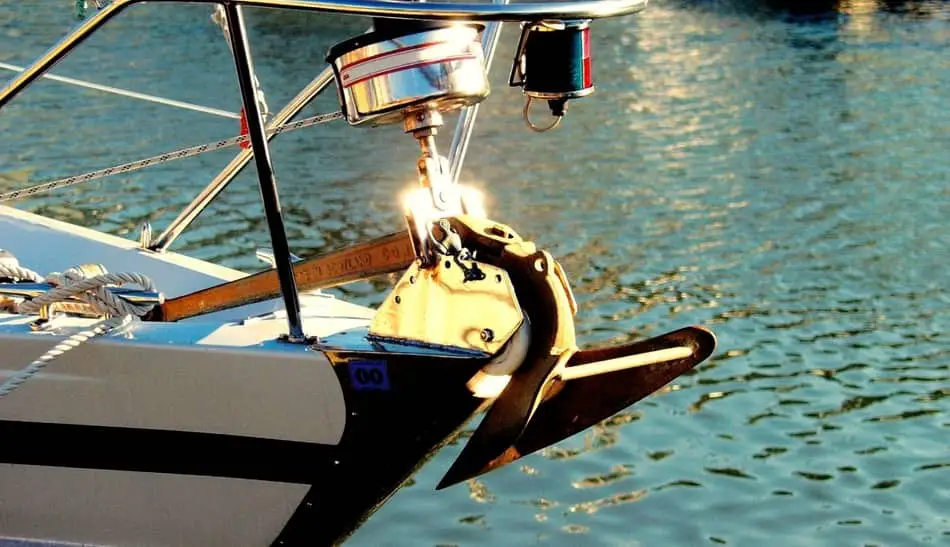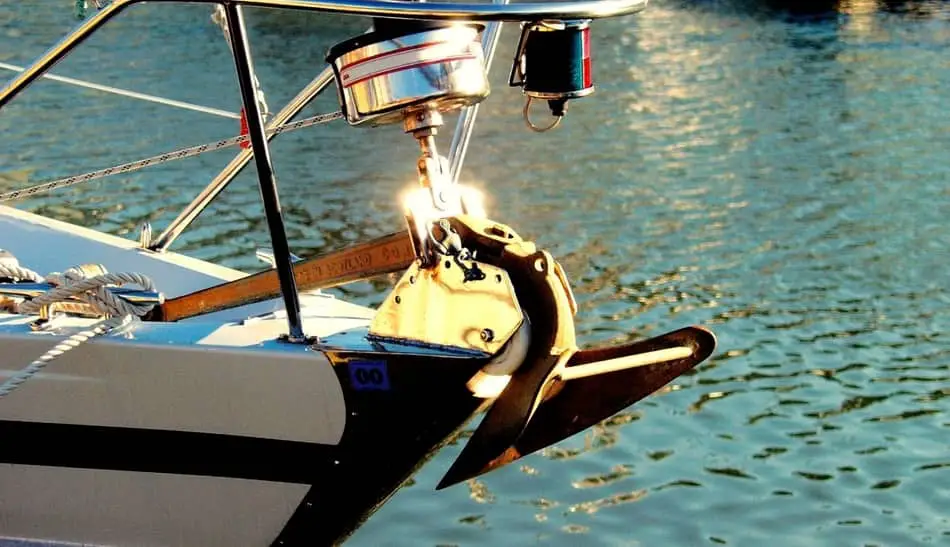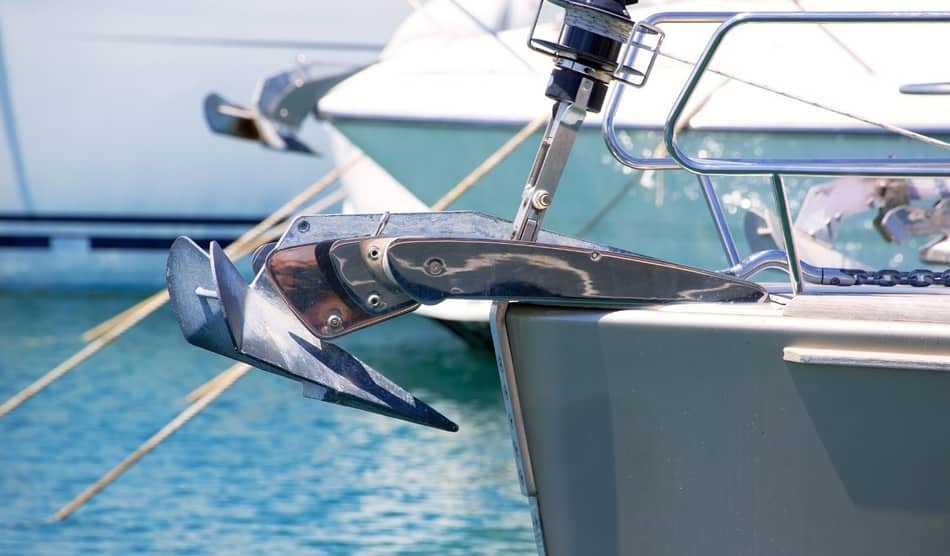Gravel or pebble category bottoms are in between rocks and sand bottoms. The gravel bottom is not as thick as rock bottom, and it is not as soft as sand or mud bottom. Here are some anchors that work well in gravel or pebble bottoms.
The best boat anchor for gravel bottoms is Modern, CQR, and Fisherman anchors. All among them are good for gravel bottoms because they have a sharp tip on the anchors (especially Northill anchor). So, they will hold well in gravel bottoms. Don’t use Fluke anchors for gravel bottoms (Bruce is okay).
Delta and Modern anchors such as Manson Supreme or Mantus or Rocna will work well in gravel bottoms. Also, Northill or fisherman anchor would be a good choice for rock bottoms. Don’t use fluke anchors for rock bottoms. Bruce anchor will not work well and take some time to set in rock bottoms.
Modern, Delta, and CQR anchors are a bit expensive. If you have a good amount in the wallet, then the best option is modern anchors. These anchors will work well in all types of bottom types (mostly) and have good holding power and strength. Modern anchors work well in gravel and any bottoms than other anchors.
That doesn’t mean that CQR, Delta, and Fisherman anchors are not suitable for gravel bottoms. But, when it comes to modern anchors VS others, definitely modern anchors will win the battle because modern anchors are designed like that (robust). Sometimes, CQR anchors may not set and reset well in gravel bottoms due to the hinge design.
As I said, for gravel bottoms, modern, Delta, CQR, and fisherman anchors suit well. That doesn’t mean that those types of anchors (modern, Delta CQR, and fisherman) will work well only in the gravel bottom.
Modern, CQR, Delta, and fisherman anchors work well in weed, grass, rocks, gravel, sand, clay, silt, and mud bottoms. Like that, if you buy one anchor, it will work well in at least 2 or 3 bottom types as well (notably, these four anchors, modern, CQR, and fisherman work well mostly in all bottom types).
Meaning you should not only consider only one bottom type while buying an anchor for your boat. For example, assume that you are purchasing a fluke anchor for boating in mud or sand bottoms. Generally, fluke anchors will not work well in grass, weed, and rocky bottoms.
And, all the time, you may not go for boating only in a specific (or the same place) place. Sometimes, you might change the location, and if you change the location, then sometimes you might encounter some other types of bottom conditions. Then you may not be able to use that fluke anchor. So, you should consider all these things while buying an anchor.
Now, that you have been selecting an anchor for a rock bottom, those three anchors (modern, CQR, and fisherman) will work well in rocky bottoms. Now, let’s see those three anchors in detail.
To get more info about the different bottom types and the different anchors, check my article on Choosing a perfect anchor for your boat: All you need to know (opens in a new tab). It is a detailed analysis of all the bottom types and their respective anchors that suit for all those bottom types.

1. Modern anchors or New generation anchors
These anchors are a bit expensive. But, these Modern anchors or New generation anchors are the best anchors available in the market. If you have a good amount in the wallet, then go for these types of anchors. We will now see for which type of bottom conditions we can use these Modern anchors or New generation anchors.
The Modern anchors or New generation anchors can be used for most of the types of bottoms (gravel, rock, sand, mud, weed, grass, silt, and clay). Some of them are Rocna, Mantus, Manson Supreme, and Spade. These anchors set well in all types of bottom types.
| Modern anchors | Setting ability (for 5 points) | Resetting ability (for 5 points) | Holding power (for 5 points) | Robustness (for 5 points) |
| Mud | 5 | 4 | 5 | 4 |
| Sand | 5 | 5 | 5 | 5 |
| Grass | 4 | 4 | 5 | 4 |
| Weed | 4 | 3 | 5 | 4 |
| Rock | 4 | 4 | 5 | 4 |
| Gravel | 4 | 4 | 5 | 4 |
| Silt | 5 | 5 | 5 | 5 |
| Clay | 5 | 4 | 5 | 5 |
You can consider these anchors as a category of non-hinged CQR or Plough anchors OR delta anchors. If you are going for bigger ones, then buy one of these anchors.
All these anchors will set quickly, and these types of anchors are the best ones for your boat. These anchors will penetrate well in the ground instantly after dropping them. These anchors are heavy & big and can be used for big boats.
These anchors are very strong and durable. Mostly they can withstand any type of bottoms. These anchors will be a perfect choice for many big boats. These modern or new generation anchors can be divided into two categories. One roll bar and another will not have a roll bar anchor. Now, we will see them.
A roll bar anchor has a circular bar mounted on the back of the anchor, and it is useful for setting the anchor back if the anchor comes out off the bottom due to the wind or currents. Mantus, Manson Supreme, Rocna anchors come under the category of Rollbar.
A non-roll bar anchor doesn’t have any circular bar mounted on the back like a roll bar anchor. Some of the anchors under the non-roll bar category are Spade, delta anchor, etc.
Mantus anchor

Mantus anchor (linked to Amazon) has a 50% weight in a tip to body ratio, it has a very sharp tip and aimed towards the ground, which means the anchor sets very quickly. This has a roll bar, which will give support if the anchor rolls side. This anchor is disassemblable. Mantus sets very well among all the anchors.
Manson Supreme anchor

Manson Supreme anchor (linked to Amazon) has a 23% weight in a tip to body ratio. Manson Supreme shank is solid, thicker, and has broader shank than Mantus shank. The tip of the Manson Supreme anchor is aimed towards the ground. This has a roll bar, which will give support if the anchor rolls side. This is a robust anchor, and good for many boats.
Spade anchor

Spade anchor (linked to Amazon) has 42% weight in a tip to body ratio, it is a very sharp tip and aimed downwards, which means the anchor sets very quickly. Shank is removable. Spade anchors are very best for short scope. This one doesn’t have a roll bar on it. But, it has a fluke in the shape of the concave lens. So, it will reset well.
Rocna anchor

Rocna anchors (linked to Amazon) are one of the most famous anchors. Rocna anchors have a sharp tip, and it is aimed downwards, which means the anchor sets very quickly. These anchors are perfect for many bottom conditions.
The advantages of Modern or New generation anchors
- Modern anchors are the perfect anchors for all types of bottoms.
- Modern anchors have a sharp tip and penetrate well into the bottom.
- Modern anchors set quickly in the bottoms.
- Modern anchors penetrate deeply into the bottoms for better bonding power.
- Modern anchors are easy to stow on the bow roller.
The disadvantages of Modern or New generation anchors
- Modern anchors penetrate deep into the bottom, and it may be hard to retrieve them back.
- Some of the modern anchors cannot be stowed in the boat.
- Modern anchors are expensive.
- Some of these designs have more shank weight. If the anchor has more shank weight, it might bend in the long run. But, don’t worry about that, it won’t bend that easily.
2. CQR or Plow anchor

CQR or Plow anchors are also known as hinged anchors, and one of the good ones for anchoring. Many big boaters will use these anchors in their boats. We will now see for which type of bottom conditions we will use these CQR or Plow anchors.
CQR or Plow anchors are used in the bottoms like gravel, rock, sand, grass, clay, weed, mud, and silt. But in grass, weed, and very soft bottoms, CQR anchors won’t set as nicely as it sets in normal bottoms. Still, CQR anchors are okay for grass, weed, and very soft bottom types.
Image is linked to Amazon

CQR or plow anchors (linked to Amazon). Check the price in amazon, and it is worth buying a CQR or plow anchor for gravel, rock, clay, sand, mud, grass, weed, and silt bottom (sometimes, may not work well in grass, weed, and very soft bottoms). But, the problem with CQR anchors is the hinge, the anchor may roll sideways if the wind or current changes. Consider that point while buying a delta anchor.
| CQR anchors | Setting ability (for 5 points) | Resetting ability (for 5 points) | Holding power (for 5 points) | Robustness (for 5 points) |
| Mud | 4 | 3 | 5 | 4 |
| Sand | 4 | 3 | 5 | 5 |
| Grass | 3 | 2 | 3 | 3 |
| Weed | 3 | 2 | 3 | 2 |
| Rock | 4 | 3 | 4 | 4 |
| Gravel | 4 | 4 | 4 | 4 |
| Silt | 5 | 4 | 5 | 5 |
| Clay | 5 | 4 | 4 | 5 |
CQR or Plow anchors can be stowed conveniently in a roller at the bow, and have been popular with cruising sailors and private boaters. CQR or Plow anchors are generally good in all types of bottoms, except soft bottoms.
The only problem with CQR or Plow anchors is that it won’t set properly. Generally, it takes time to set due to the hinge. And another problem with CQR or Plow anchors is it will roll down if the wind or current changes. So, it might be an issue for many boaters.
This anchor is a big one, and due to its hinged design, it is more difficult to stow it in the boat. You need to consider those things while buying a CQR or Plow type anchors. To prevent those problems, they invented non-hinged types of anchors known as Delta or Wing anchors. Many modern anchors are also designed similarly to a Plow style anchor. Some of them are Rocna, Manson Supreme, Mantus, Spade anchors.
In the below table, I listed the CQR or Plow anchor size based on the boat size (source). The values may vary a little bit if the boat weight is heavy or very light.
| Anchor Weight (in lbs.) | Boat Length (in feet) |
| 15 lbs. | up to 20 feet |
| 20 lbs. | 20-30 feet |
| 25 lbs. | 22-26 feet |
| 35 lbs. | 26-45 feet |
| 45 lbs. | 32-58 feet |
| 60 lbs. | 45-65 feet |
| 75 lbs. | 52-72 feet |
| 105 lbs. | 70-90 feet |
The advantages of CQR or Plow anchor
- CQR anchors are excellent in gravel, rock, sand, grass, clay, mud, weed, and silt bottoms (sometimes, may not work well in grass, weed, and very soft bottoms).
- CQR anchors can be stowed conveniently in a roller at the bow.
- CQR anchors penetrate deep into the bottom and have good holding power.
- CQR anchors will be the right choice for big boats because these anchors are heavy anchors.
The disadvantages of CQR or Plow anchor
- Sometimes, CQR anchors will not set properly or holds less in the grass, weed, and very soft bottoms.
- CQR anchors roll over to the side easily than other anchors.
- CQR anchors take more space, and can’t be stowed easily in the boat due to its hinge design.
- CQR anchors take time to set at the bottom.
3. Delta or Wing anchor or Non-hinged anchor

Delta or Wing anchors are also known as non-hinged anchors, and one of the good anchors. Delta or Wing anchors are many ways similar to CQR or Plow anchors. We will now see for which type of bottom types we will use the Delta or Wing anchors.
The Delta or Wing anchors are used in the bottoms like gravel, rock, grass, clay, sand, mud, weed, and silt. But in the grass, weed, and very soft bottoms, Delta or Wing anchors won’t set as nicely as it sets in normal bottoms. Still, they are okay for weed, grass, and very soft bottom types.
“Delta anchor is almost the same as CQR anchor (performance-wise).”
Image is linked to Amazon

Delta or wing anchor (linked to Amazon). Check the price in amazon, and it is worth buying a Delta or wing anchor for gravel, rock, clay, sand, mud, grass, and silt bottom. But if you are thinking of purchasing a delta anchor, then you should know that sometimes in weed, grass, and very soft bottoms, the delta anchor may not set well at the bottom. Consider that point while buying a delta anchor.
| Delta anchors | Setting ability (for 5 points) | Resetting ability (for 5 points) | Holding power (for 5 points) | Robustness (for 5 points) |
| Mud | 4 | 4 | 5 | 4 |
| Sand | 4 | 3 | 5 | 5 |
| Grass | 4 | 3 | 4 | 2 |
| Weed | 3 | 3 | 4 | 3 |
| Rock | 4 | 3 | 4 | 4 |
| Gravel | 4 | 4 | 4 | 4 |
| Silt | 5 | 4 | 5 | 5 |
| Clay | 5 | 4 | 4 | 5 |
Delta or Wing anchors can be stowed conveniently in a roller at the bow, and have been popular with cruising sailors and private boaters. Delta or Wing anchors are generally good in all types of bottoms, except soft bottoms.
But, Delta or Wing anchor cannot be stowed inside the boat properly because we can’t dismantle a delta anchor. You need to consider all these things while buying a Delta or Wing type anchor.
In the below table, I listed the Delta or Wing anchor size based on the boat size (source). The values may vary a little bit if the boat weight is heavy or very light.
| Anchor Weight (in lbs.) | Boat Length (in feet) |
| 13 lbs. | 17-29 feet |
| 22 lbs. | 30-40 feet |
| 33 lbs. | 40-49 feet |
| 44 lbs. | 47-57 feet |
| 55 lbs. | 53-63 feet |
| 66 lbs. | 57-70 feet |
The advantages of Delta or Wing anchors
- Delta anchors are excellent in gravel, rock, sand, mud, clay, grass, weed and silt bottoms (sometimes, may not work well in weed, grass, and very soft bottoms).
- Delta anchors can be stowed conveniently in a roller at the bow.
- Delta anchors penetrate deep into the bottom and have good holding power.
- Delta anchors will be the right choice for big boats because these are heavy anchors.
The disadvantages of Delta or Wing anchors
- Sometimes, Delta anchors will not set properly or holds less in the weed, grass, and very soft bottoms.
- Delta anchors can’t be stowed easily in the boat due to its hinge design.
- Delta anchors take time to set at the bottom.
4. Fisherman
Fisherman anchors are also suitable for gravel bottoms. But, the problem with them is they are huge, and it can be so hard to stow them in the boat (anchor edges are very sharp). One of the best is the Northill anchor. Nowadays, many people are not going for fisherman style anchors because all the modern anchors are doing what the old fisherman anchors do.
The advantages of fisherman anchors are they set well in all types of bottoms (mostly). Still, it is an excellent choice for gravel bottoms if you are not willing to go for expensive anchors.
Related posts
Check my article on Choosing an anchor for your boat click here
Check my article on boat anchors for Offshore (oceans or seas) click here
Check my article on boat anchors for sand bottom click here
Check my article on boat anchors for mud bottom click here
Check my article on boat anchors for clay bottom click here
Check my article on boat anchors for grass bottom click here
Check my article on boat anchors for weed bottom click here
Check my article on boat anchors for rock bottom click here
Bottom line
Delta and Modern anchors such as Manson Supreme or Mantus or Rocna will work well in gravel bottoms. Also, Northill or fisherman anchor would be a good choice for gravel bottoms. Don’t use fluke anchors for rock bottoms. Bruce anchor will not work well and take some time to set in gravel bottoms.
As I said, one anchor will set well in different types of bottoms. So, choose an anchor that works well in the place where you will go for boating and some neighboring places as well. By doing that, one day if you go to another place for boating, then it will help you a lot.
